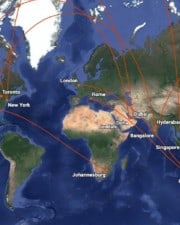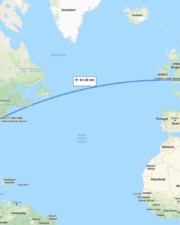Once upon a time, flight was experimental and every flight was full of risk. Thankfully, we have reached the point where traveling by plane really is the statistically safest way to travel. Still, no manner of travel is 100% safe, which begs the question – which flight routes are most dangerous?
Table of Contents
- 1. The Bermuda Triangle
- 2. Flights Into Indonesia
- 3. Flights Across Certain African Nations
- 4. Certain Africa to Europe Flights
- 5. Certain Flights in Post-Soviet States
- 6. Certain Flights From the Middle East and North Africa Into Europe
- 7. Flights Into and Out of Syria
- 8. Flights Into Nepal
- 9. Certain Latin American Countries
- 10. Longer and Turbulent Flight Paths
One of the most difficult aspects of tabulating a list like this has to do with the fact that there are many ways in which a flight path could come to be considered “dangerous.”
There are the obvious suspects, such as areas in which there is severe weather and, thus, the added potential for a crash or other unfortunate accident to occur.
Then there are places where the logistics or political nature of the region combine to create a dangerous flight path borne not of nature, but human action.
The latter can actually often be far more dangerous and deadlier than the former. Pilots train to handle difficult weather conditions as best as possible, and flight path planners can try and help pilots avoid them altogether as best as possible.
But what about when that equipment fails to function, or there are other dangers in a region that can impact flights?
1. The Bermuda Triangle

For those who have not heard of it, the Bermuda Triangle is an area in the vicinity of the Caribbean and Southern Atlantic where dozens of planes and ships have allegedly disappeared over the decades.
Where in particular the Bermuda Triangle “is,” however, is not agreed upon. In stories relating to these disappearances, the boundaries shift, though they are commonly between Cuba, Jamaica, Puerto Rico, and Hispaniola.
For believers in the myth, this constitutes a zone of peril and death.
Of course, as anyone who has flown to travel hotspots such as Miami can tell, this isn’t the case. Flights pass over the Bermuda Triangle and emerge perfectly fine every day. Even so, weather conditions in the area can make it a turbulent, if hardly legendarily dangerous, place to fly.
2. Flights Into Indonesia

Far more often, what contributes to a flight path being risky has as much or even more to do with the aircraft in use in the region as it does weather conditions. Nations such as Indonesia are a good example.
2015 was an incredibly tragic year for the Indonesian flight industry, with three crashes occurring within months of one another. These accidents proved extremely fatal, with 54, 162, and at least 100 people dying in the three incidents.
With more than 300 deaths in the span of a few months, Indonesia had become one of the most dangerous places to fly.
That danger didn’t occur suddenly, either. Indonesia’s lagging safety standards has resulted in the EU banning 59 of the country’s 63 airlines from flying within its airspace. Further, the FAA has placed Indonesia on a list of Category 2 nations which have failed to meet international regulations for air safety.
3. Flights Across Certain African Nations

In 2008, the Republic of Congo was the scene for another tragic crash, one which claimed the lives of 40 people. More tragically still, Congo is not alone within Africa in terms of battling difficult safety records. Among the many issues plaguing countries across the continent are dangerous flight paths.
The continent as a whole has one of the most troubling safety records in terms of flight paths of any area in the world.
A five-year study found Africa to have an accident rate of 12.45 incidents per 1 million flights. That may not seem like much, and it’s still safer than road travel, but it’s more than double the rate of any other region.
For comparison’s sake, the global average was 2.48 accidents per 1 million flights in the same period.
This is not an isolated incident, either. 2014’s accident rate in Africa was 11.18, set against a global average of roughly 1.92.
4. Certain Africa to Europe Flights

Africa’s flight path woes are not confined to the nations within the continent, either. As criticism of some of its countries has become more vocal, EU nations have begun to view Africa-to-EU flights managed by certain African airlines or nations as too hazardous.
Africa’s most dangerous flight paths include nations which have been severely criticized for their lack of safety regulations, such as Angola, Eritrea, Congo, and Sierra Leone. These nations, along with Sudan, Eritrea, and others, have been banned from flying to the EU due to safety concerns.
It should be said at this point that many African nations, such as Egypt and South Africa, do not share these countries’ fate, and are far more welcome in the global air traffic community.
That said, at present, human error and safety oversight have made other Africa-to-Europe flight paths among the most dangerous in the world.
5. Certain Flights in Post-Soviet States
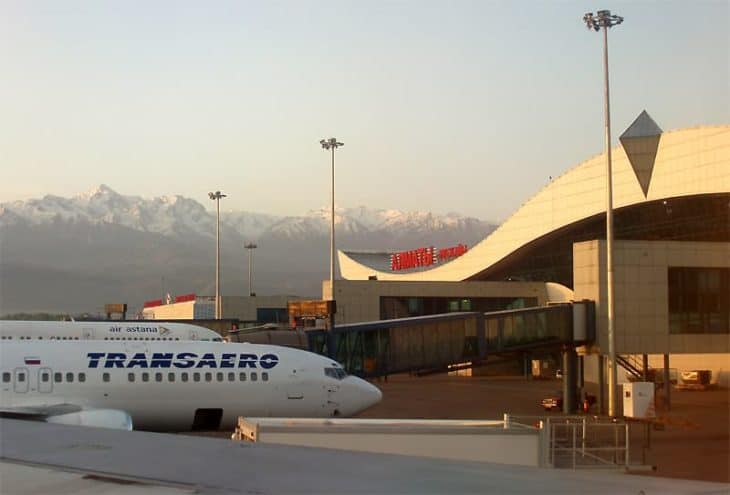
The Soviet Union may have collapsed nearly 30 years ago by this point, but its legacy lives on in an unfortunate way with respect to dangerous flights and risky flight paths in its former territory.
In particular, the Commonwealth of Independent States (CIS) is a collection of post-Soviet states which form a loose coalition for international purposes. For flight purposes, however, they continue to be plagued by older technology paired with climates that can make safe flights more difficult.
For example, Kazakhstan has landed on that same list of no-fly nations where the EU is concerned. In addition, the United Nations has issued a red flag warning for some flights in Georgia.
Add to that the downing of Malaysia Airlines flight MH-17 in Ukraine due to the Donbass War, and the issues with flying into these regions come clearer into focus.
6. Certain Flights From the Middle East and North Africa Into Europe

In 2010, Tripoli in Libya was the scene of a tragic crash that claimed the lives of 103 passengers. More tragically still, while the incident was extreme, it was not an isolated one.
A five-year review of the region’s accident rate turned up a rating of 5.43, more than the global average. In addition, both Afghanistan and Libya are barred from sending flights to Europe due to perceived dangers involved. What’s more, Lebanon has received a red flag from the ICAO.
That being said, not every flight path or airline contribute equally to that negative rating. The region is also home to dependable mainstays of international travel such as Emirates and Qatar Airways.
7. Flights Into and Out of Syria
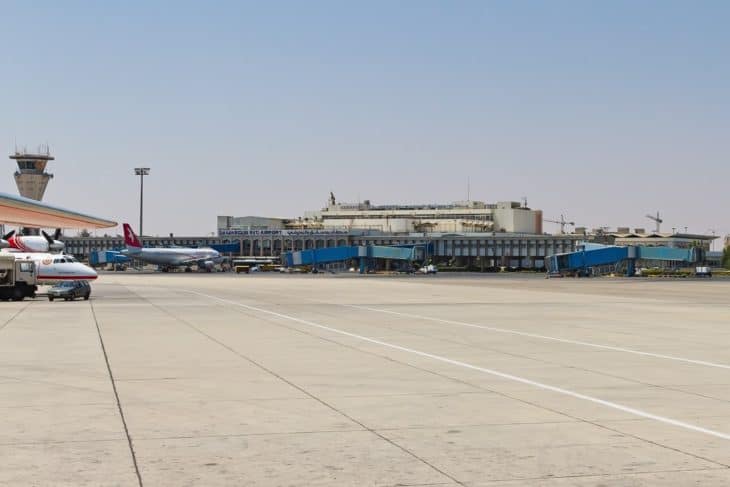
This is the most obvious case of a flight path making our list for reasons which are almost entirely due to manmade rather than natural disasters. The Syrian Civil War has claimed countless lives, and the fighting has made its flight paths among the most dangerous in the Middle East.
The United States Department of State has issued a travel warning against traveling to Syria, and the same holds true for the UK and Canada. While Aleppo Airport may soon reopen, travel and flight warnings largely remain in effect.
As if the internal situation was not hazardous enough, there is also the fact that airlines which are traveling to Syria at the moment are often from other at-risk areas within the Middle East and Africa.
These factors combine to make Syria one of the most tragically manmade no-fly zones and hazardous flight paths in the world.
8. Flights Into Nepal
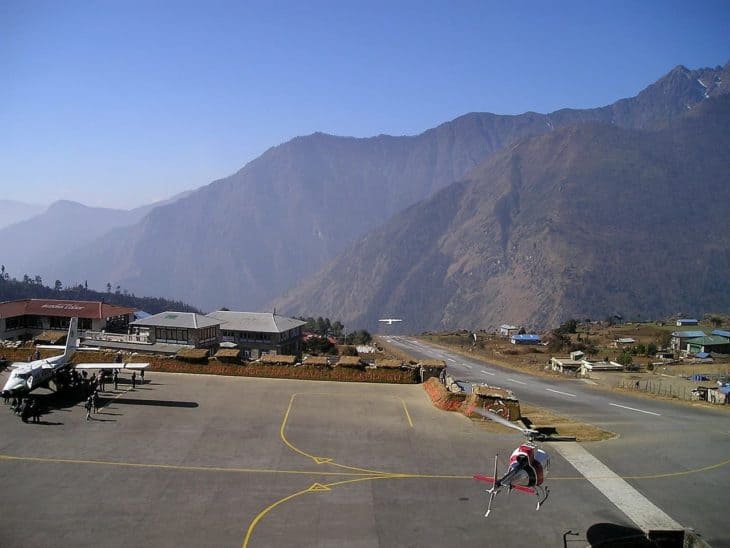
Nepal has a well-won reputation for being one of the most peaceful places on Earth. Unfortunately, however, it has not kept up in that regard with respect to its air travel, with flights into the nation ranking among the riskiest in the world.
How could that be? For one thing, Nepal’s terrain is notoriously mountainous, which makes for a rougher ride. That is because air moves through mountains and bounces upward in such a way as to be potentially disruptive. Normally, this can cause some turbulence. In Nepal, however, it can cause worse.
Numerous accidents have occurred in recent years in Nepal, making it yet another country whose planes are no longer welcome in the EU. What’s more, flights to Lukla Airport near Mt. Everest has the added hazard of being so near the largest mountain in the world.
9. Certain Latin American Countries
While the Bermuda Triangle itself may be largely a myth, the dangers of flying into certain areas in Latin America are all too real. The region is home to a safety record of 3.36 over five years, which is above the global average.
What contributes to this?
One issue is that these countries can often have older technology. This can make flights into and out of the area more dangerous, especially when paired with the region’s troubling safety record.
Another issue is that these countries are also located along the Equator. Tropical storms and other sudden weather conditions can pair with older flight technology or lax safety standards to make them more hazardous places to fly.
10. Longer and Turbulent Flight Paths
One of the points of commonality between many of the flight paths to make this list is the fact that they are long range. Those Africa-to-Europe and flights into the Latin American countries from elsewhere often involve long distance flights.
As with any time where greater distance is involved, however, this can make for a trickier flight. The longer a plane stays in the air, the greater the likelihood something can go wrong. While 99.9% of the time nothing does, the odds are nevertheless increased the longer the flight.
The same goes for flights over turbulent areas. That is one reason why, despite the fact it is not at all the legendary killer conspiracy theorists claim it to be, the Bermuda Triangle still makes this list.
Related Posts

